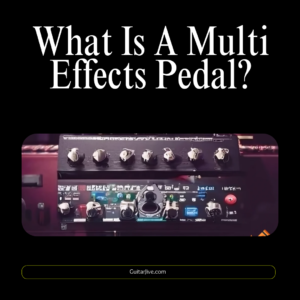Introduction
If you are into your guitar effects then you would have undoubtedly heard of fuzz, but have you ever wondered what it’s all about? How is fuzz different from overdrive and distortion? Why you need to try a fuzz pedal in your guitar rig. These days, you can choose from dozens — if not hundreds — of different types of fuzz pedals. This guide will show you all you need to know, so you can answer the question – What is fuzz?

History Of The Fuzz Pedal
Fuzz is a guitar effect that has developed a cult following since its invention in the 1960s. Throughout the late 1950s, guitarists were pushing what they could get out of their amplifiers at the time in search of a new sound. Fuzz was initially used by artists such as Grady Martin, who discovered it by using a faulty channel on a studio mixer that produced a fuzzy sound. Link Wray also used it in “Rumble” where he poked holes in his speaker cone to create the iconic tone.
The fuzz tone was created, but there still wasn’t a method of recreating it without destroying equipment. This was until 2 engineers who worked with Grady Martin designed a circuit that could reproduce the sound. The idea was presented to Gibson and the Maestro “FZ-1 Fuzz Tone” was created.
It was long considered an inappropriate or gimmicky effect until bands like the Stooges, Pink Floyd and The Rolling Stones brought fuzz pedals to mainstream audiences during the rock music explosion of the 1960s and 1970s. The Rolling Stones used the Maestro during “I Can’t Get No Satisfaction”. Subsequent pedals were created by Arbitrer Electronics Ltd in the form of the “Fuzz Face”, which was famously used by Jimi Hendrix. Electro-Harmonix came into the game with the “Big Muff”, which is still available in different variations today.
How Fuzz Pedals Work
You may hear people talk of mythical components which go into a fuzz pedal, which makes it unique. So how do they work?
A fuzz circuit is generally a 2 or 3 stage amplifier. If you’ve read the Overdrive v Distortion guide you’ll recall that they tend to use Op Amps in their amplification stages. Fuzz pedals use transistors. It is these transistors and the choice of which are used which can have a significant impact on the sound. Generally speaking, there are 2 main types:
- Silicon transistors, have high gain, and give more high end but can sound harsh.
- Geranium transistors, have a lower gain but give a warmer, smoother sound.
In principle, the fuzz pedal takes the input signal, amplifies it, and clips it, similar to a distortion pedal but much more aggressively. The hard clipping turns the input sine wave into a square wave. You’ll notice how different it is from the soft clipping in overdrive and even more extreme than the hard clipping in distortion.

The output signal has our original frequency at its core but there are also harmonics present up to the 6th harmonic of our frequency. The level of these harmonics changes depending on the knob settings that the user has set. This is what creates that fuzz sound.

Fuzz Pedal Circuit Design
What is inside of your fuzz pedal to make that sound? A fuzz circuit can be as simple as just 9 components at its core. Indeed this is what the “Fuzz Face” had and it was good enough for Jimi Hendrix. Of course, this is a simple example and today there are lots of different types, but most will probably be based upon the historic design. Below you will see a circuit diagram of what’s at the heart of a simple fuzz circuit.

The circuit has an input amplification stage, an output amplification stage, and a feedback control circuit. Feedback control is essential to rid the output of unwanted signals and also make the gain of the fuzz more manageable and constant.
How To Use Fuzz
So you’ve got this far, but how do you use your fuzz pedal?
Ideally, you’ll want it at or near the start of your pedal chain so that other pedals aren’t already amplifying the signal. Then run it into the input of your guitar amplifier, to get the best out of your pedal it would ideally be a tube amp on the clean channel. Set the “Volume” and “Gain” or “Fuzz” knobs to their mid position. Then slowly start experimenting by adjusting each one up and down in turn, until you find that sweet spot. Try aiming for a setting that allows you to identify each note that you play with enough gain to create that fuzz sound. Also, experiment with using the “volume” knob on your guitar, this controls the voltage which should allow you to clean up your signal by rolling the volume down.
Fuzz Pedal Examples
Today there are many fuzz pedals that you can buy, you can still purchase the “Fuzz Face” which is made by Dunlop, the “Big Muff” is fairly commonplace amongst guitar pedal boards around the world. Behringer makes the “Super Fuzz SF300” which is well worth a try as an affordable way into the world of fuzz.
Conclusion And Closing Thoughts
So hopefully now you’ve got a fairly good understanding of what fuzz is. It’s an iconic sound that was created in the 1960s and is still widely used and further developed today. The fuzz effect pedal is a staple of any guitarist’s collection, if you haven’t tried one, then you need to go and get one now, after all, who doesn’t want to sound like Jimi Hendrix?




Pingback: A 5-Step (How To) Tremolo Pedal Guide | Guitar Jive
Pingback: Pedalboard Signal Chain: A Simple (But Complete) Guide